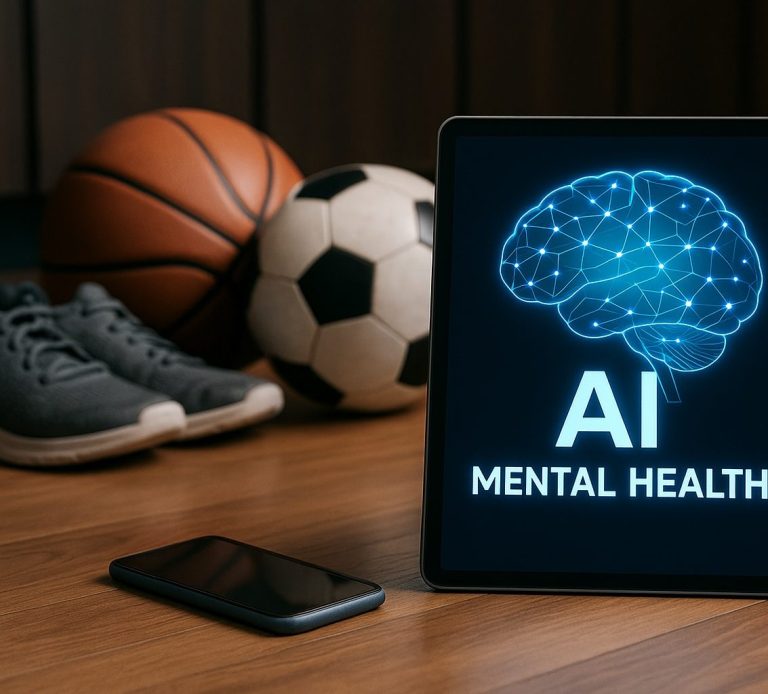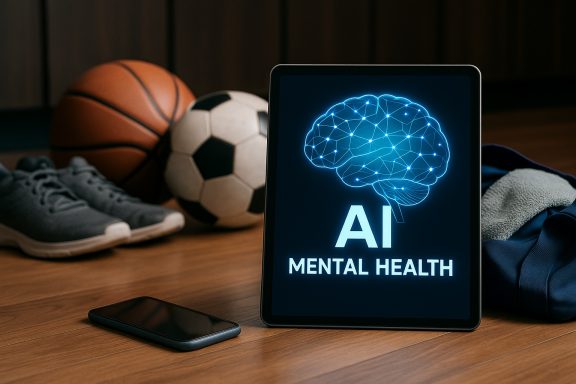BRAINews
Our latest published news
BRAINews #2
Mental Health woes sideline young athletes – Can AI help?
Posted by Dr. Daniel López - May 23, 2025

Mental Health woes sideline young athletes. Can AI help?
Many young athletes face depression or anxiety. A 2024 study found that those with these mental health struggles were far less likely to keep playing sports than their peers [1]. The toll isn’t just mental – it can get physical. Teens with untreated depression or anxiety often had chest pain or shortness of breath during exercise [1]. Notably, those receiving antidepressant treatment did not experience these problems, suggesting that proper care helps young athletes stay in the game [1].
AI as a Mental Health ally
Now, one solution may lie in smart technology. In 2023, scientists developed an artificial intelligence model to detect and decode athlete stress before it derails performance [2]. The AI was trained on data from 500 track-and-field athletes to classify each athlete’s anxiety source – physical strain, competition pressure, or internal worries – with nearly 90% accuracy [2]. This tool could give an early warning when an athlete is struggling and pinpoint what kind of help is needed – rest, coping strategies for anxiety, or other support [2].
Why It matters
Both studies show that mental well-being is central to athletic success [1][2]. Left unaddressed, issues like anxiety and depression can bench even the most talented youth athletes. But these findings also offer hope: by treating mental health conditions and leveraging tech to monitor wellness, teams can help young athletes thrive on and off the field. These insights offer a path to ensure no athlete has to choose between their mental health and their sport.
Main references:
[1] Vyas, AJ, Sun, M, Farber, J, Dikdan, SJ, Ruge, M, Corgan, S, Johnson, D & Shipon, D 2024, ‘Mental Health and the Youth Athlete: An Analysis of the HeartBytes Database’, Journal of Orthopedics and Sports Medicine, vol. 6, pp. 144–151. https://doi.org/10.26502/josm.511500153
[2] Guo, L 2023, ‘Analysis and prediction of athlete’s anxiety state based on artificial intelligence’, PeerJ Computer Science, vol. 9, e1322. https://doi.org/10.7717/peerj-cs.1322
BRAINews #1
AI Finds a Clue to Youth Depression in Text Messages
Posted by Dr. Daniel López - May 20, 2025

AI Finds a Clue to Youth Depression in Text Messages
Teen mental health problems are on the rise, yet many young people who experience depression never receive help [2]. By the end of adolescence, up to one in five teens will have had at least one episode of clinical depression – but most go untreated [2] . Health leaders have warned of a youth mental health crisis [2], urging innovation in how we detect and address these issues. One promising avenue is technology. Smartphones and artificial intelligence (AI) are increasingly seen as tools that could transform mental health care for young people . A recent study led by researchers at Columbia University and collaborators explores this idea by examining whether AI can passively spot signs of depression in teens’ everyday text messages.
Analyzing 1.2 Million Teen Texts
In a study, scientists collected an enormous dataset of approximately 1.2 million messages typed by 90 adolescents over one year [1]. Importantly, these teens had varying levels of depression, from no symptoms to diagnosed major depressive disorder (MDD). Each week, the researchers assessed which teens met clinical criteria for depression. They then used machine learning to comb through the teens’ digital communications (texts, social media chats, etc.) looking for linguistic patterns. Specifically, they measured three types of words in each week’s texts:
- Sentiment words – the overall emotional tone (positive or negative) of the messages.
- First-person singular pronouns – how often teens used self-focused words like “I, me, or my.”
- Absolutist words – terms like “always, nothing, or completely,” which reflect all-or-nothing thinking.
The goal was to see if changes in these language features could reliably signal when a teen was experiencing a depressive episode . In essence, the AI looked for subtle shifts in how teens communicate during weeks they were depressed versus weeks they were not.
A Telltale Sign: “I… I… I…”
After crunching the data, the AI revealed one striking finding: when teens were depressed, they talked about themselves a lot more. In weeks where a teen met the threshold for MDD, they showed a significant uptick in first-person pronoun use compared to their own usual level [1] . Statistically, the odds of being in a depressive episode rose by nearly 30% for each unit increase in self-focused pronoun use [1]. In contrast, the sentiment of their messages (how positive or negative the language was) didn’t show a clear link to depression [1]. Even surprisingly, absolutist words – thought to indicate black-and-white thinking – were not associated with weekly mood status either [1]. It was the “I, me, my” language that stood out.
Psychologists note that people with depression often ruminate on themselves and their problems, which might explain this pattern. The teens weren’t necessarily using more negative words; rather, they were referring to themselves more frequently. This suggests that self-focused language could be a linguistic “fingerprint” of depression in youth. As the researchers concluded, passively monitoring pronoun use in smartphone communications may help detect when a teen is depressed, opening the door for timely support [1].
Why It Matters
Early identification is crucial – especially since so many teens with depression go undiagnosed and untreated [2]. An AI-based system that flags concerning changes in a young person’s texts or social media posts could alert parents, clinicians, or even the teens themselves to do a mental health check-in. This study’s findings, while preliminary, demonstrate that everyday digital data contain meaningful signals about mental well-being [1]. Using such signals for preventive screening could potentially reach teens who might never proactively seek therapy. It’s a step toward leveraging the devices and platforms teens already use to close the youth mental health care gap.
The research also underscores that more data doesn’t always mean complex indicators – sometimes a simple linguistic marker can be impactful. Here, a single factor (pronoun usage) outperformed more obvious cues like negative wording. This insight could help refine digital mental health tools to focus on the most telling markers. As one example, a smartphone app might quietly analyze a teen’s texting patterns (with proper privacy safeguards) and notify a school counselor or caregiver if the teen’s self-referential language spikes.
Looking Ahead
Experts caution that AI interventions must be handled carefully. Privacy, consent, and avoiding false alarms are all major considerations before deploying any monitoring tool in real life. Moreover, not every teen who says “I” a lot is depressed – language patterns are just one piece of the puzzle. The current study involved fewer than 100 adolescents, so larger research is needed to confirm how well these findings generalize.
Nonetheless, this work is an encouraging proof-of-concept that AI can detect subtle signs of inner struggle that humans might miss. It aligns with a broader movement in psychiatry toward “digital phenotyping,” where everyday behaviors captured by technology – from typing rhythms to speech patterns – serve as health clues. For a generation of young people fluent in texting but often reluctant to ask for help, such AI-driven approaches could literally be life-saving. By spotting depression in its early stages, families and professionals can intervene sooner with therapy, support, or simply a conversation that says “I’m here for you.” As the researchers emphasize, harnessing AI and smartphones in this way could create new opportunities for prevention at a scale never before possible [1].
In an era when youth mental health needs are urgent, studies like this offer a glimpse of a future where your phone might notice you’re suffering and help you get support – even when you haven’t said a word about it.
Main references:
[1] Funkhouser, CJ, Trivedi, E, Li, LY, Helgren, F, Zhang, E, Sritharan, A, Cherner, RA, Pagliaccio, D, Durham, K, Kyler, M, Tse, TC, Buchanan, SN, Allen, NB, Shankman, SA & Auerbach, RP 2024, 'Detecting adolescent depression through passive monitoring of linguistic markers in smartphone communication', Journal of Child Psychology and Psychiatry and Allied Disciplines, vol. 65, no. 7, pp. 932-941. https://doi.org/10.1111/jcpp.13931
[2] Harvard-MIT Mental Health Symposium highlights, June 12, 2024
© 2025 · The BRAIN Centre · All rights reserved
Necesitamos su consentimiento para cargar las traducciones
Utilizamos un servicio de terceros para traducir el contenido del sitio web que puede recopilar datos sobre su actividad. Por favor revise los detalles en la política de privacidad y acepte el servicio para ver las traducciones.

